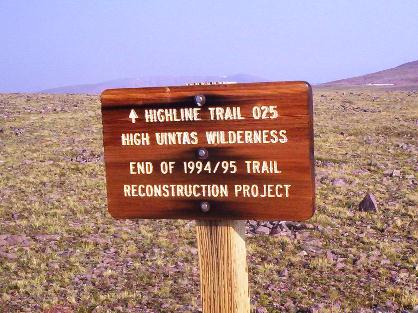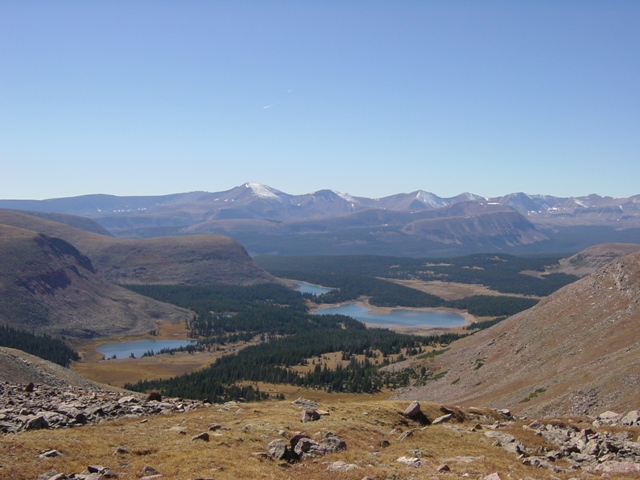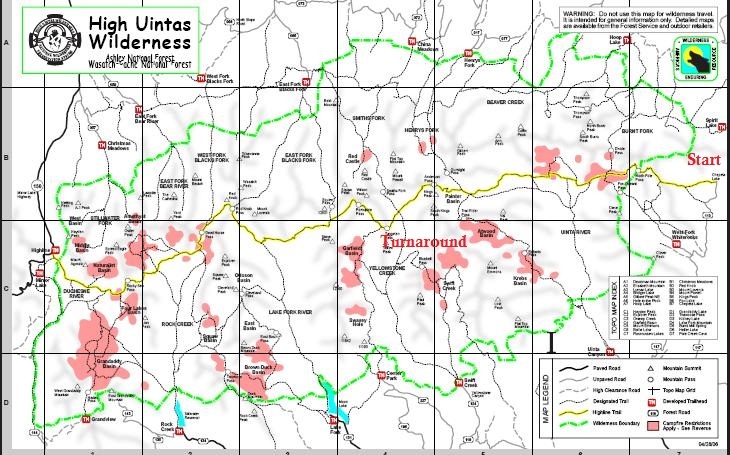
During this first year (2002-2003) of increased physical activity and adventure running, I started to push the limits even more and considered accomplishing runs that no one had ever run before in a day. One day I read in the newspaper about two guys, Craig Lloyd and Scott Wesemann, who accomplished a “Utah Triple Crown,” summitting the three highest peaks in Utah in one day. The three highest peaks are located in the Uinta Mountain range. 1- Kings Peak – 13,528, 2- South Kings Peak – 13,512, 3- Gilbert Peak – 13,442.
My first reaction was excitement, that such a feat was very cool. But when I discussed it with my brother-in-law Ed, I expressed the feeling that they did it wrong. They used a base camp instead of starting and finishing from a trail head. Ed and I were convinced that we could do it right.

Within a couple weeks, in August, we made our attempt. Unfortunately that evening it rained for several hours. Around 2:00 a.m. the rain stopped and we decided to go. Our objective was to first summit Kings Peak, next South Kings, and as we returned, go up Gilbert. Our run up Henrys Fork was great fun. As we approached the peak, we were surprised to find that about eight inches of snow fell the evening before. It wasn’t enough to stop us, but it was a bother. Ed decided to scramble quickly straight up the boulders to the summit and he beat me by 30 minutes as I took the traditional route. But once up on top, my eyes were really bothered by the bright sunshine reflected off the snow and it was getting very wet and slippery. I failed to bring sunglasses and feared of suffering snow blindness, so we decided to abort our “triple crown” and save it for another day. Our run back down the valley was fast and I enjoyed seeing Ed have so much fun. This adventure got me hooked on trying to accomplish “firsts.” (It would be another five years until I became the first person to run a “Utah Triple Crown” from the trailhead, accomplishing it on my 50th birthday. Soon after that I became acquainted with Craig and Scott).
I shortly had summited Kings Peak five times, three of those were one-day trips. Each time as I would make my way to the peak, I would run a little on the Highline trail. I knew this trail extended the length of the Uinta Mountains. I dreamed of running the entire Highline trail. As I researched it, I came across a trip report about some guys who fast-packed the entire trail in 1991. John Moellmer and Dana Miller traversed the entire 105-110 miles of the Highline Trail from Lonetree Campground (on Rt. 191 north of Vernal) to Hayden Pass (near Mirror Lake) in 3.5 days. Clearly these guys were not just average backpackers, there were extraordinary distance hikers. I didn’t realize at that time, but both John and Dana were ultrarunning pioneers in Utah. I still had never heard of ultrarunning. (In later years I became good friends with both and I have great respect for their accomplishments. They paved the way for the following generation of ultrarunners.)

I decided that I wanted to be the first to run the Uinta Highline Trail solo from Chepeta Lake trailhead to Hayden Pass, a distance of about 70 miles. I believed I could accomplish it in under 36 hours. Looking back, I was getting in way over my head on this one. The Uinta Highline trail is very remote and rugged. This is a very advanced adventure run, even for an experienced ultrarunner, especially solo. I was naïve. But I was excited to give it a try. I tried to be well-prepared, bringing with me a tent, sleeping bag, food, and extra clothes.

I began the toughest adventure of my life up to that point on September 7, 2003, a little over a year since I decided to get into shape. By about mile 10, I had a badly sore foot because of the rugged rocks and bad shoes. I climbed up and over North Pole pass and descended to the Fox Lakes. During the day, the only humans I saw had come in on horses. A thunderstorm rolled in so I stopped, set up a tent and waited for it to clear.

The trail got tougher and tougher, but I continued on. I reached the familiar basin below Kings Peak near dusk, mile 25 and called my wife to tell her all was OK. After I descended down into Yellowstone Basin, my cheap headlamp was dimming. I searched for spare batteries but could not find them. This was a major blunder. For the next few hours I only travelled one mile per hour because of difficult route finding with a very dim light. By midnight near Tungsten Pass (mile 30) the moon had set so I had no choice but to stop, set up my tent, and wait out the night. I was very discouraged because I was way behind schedule and knew it would be impossible to finish by the time my wife planned to meet me the next evening at Hayden Pass. (Actually, even if my light worked well, ahead I would have battled all night trying to navigate the trail because it becomes faint and the trail markers are very far apart.)
When morning arrived, I decided to abort and head back the way I came. Once back near Kings Peak, I called my wife, told her I was heading back, to not worry, and that I probably would be late. My hike back was slow. It rained for four hours straight and I became soaked. At Fox Lake in the late afternoon, I almost stopped for the night with some campers who had a huge heated tent, but I pushed on. More problems arose, my GPS stopped working and I headed up a wrong pass, wasting an hour.

As dusk arrived, I was on high North Pole Pass when a bad snow storm hit. I was in some serious trouble and had to get down fast. I was still six miles from my car without a light. I stumbled down the trail in the dark and fierce wind and snow. Finally down in the basin, I couldn’t find the trail anymore. I made the wise choice to find a giant boulder to pitch my tent out of the wind, take shelter, sleep, and wait out the night. I knew my wife would be worried. (Early the next morning, she called my brother-in-law Ed. He assured her that I knew what I was doing, would be fine, and they should wait longer before calling for help.)

At dawn I packed up and hiked out in a peaceful, beautiful morning and quickly called my wife when I reached cell coverage. My crazy adventure had covered 60 very tough miles and I learned many good lessons. Despite my blunders and greatly underestimating the difficulty of this expedition, I gained important experience in the Uintas which would lead to accomplishing my end-to-end goal twice in the coming years. (In 2010 I would establish a solo fastest known time starting from Leidy Peak.)
In just a year, with lots of hard work and training, and overcoming a serious injury, I had progressed from an out-of-shape couch potato to a self-sufficient long distance rugged outdoor hiker/runner. For the rest of 2003 and into 2004, I was more careful, staying closer to home. I took six trips up Mount Timpanogos and on these trips instead of being called a tortoise, I received constant complements including, “you are amazing.” I ran in remarkable places including Grand Gulch, Canyonlands, Buckskin Gulch, and Paria Canyon. My longest one-day run was near home, on the west side of Utah Lake for 37 miles.
As my mileage increased, I could no longer find people to go with me on these very long adventure runs. During the spring of 2004, I found a Utah trailrunning website and asked the owner if he knew of groups who went on these types of adventure runs. He suggested that I try “the races.” I had seen some trail race results on the Internet such as Brighton Marathon, but I still had not discovered ultrarunning. At a family gathering, in June, Ed suggested that I go run Wasatch 100. I really had no idea what that was. I had heard about it over the years but thought it was a road/pavement race up in the mountains run by crazy people. But I soon learned it was on trails (and yes, run by crazy people) and I quickly became very excited about the idea. I tried to figure out how to register but learned from the race director that the race was full (of course!). He suggested that I look at the Bear 100.
Suddenly this opened up a new world to me. Up to that point I had run about 1,300 miles on the trails, but I do not recall even seeing another trail runner on the trails ever, even with about ten trips up Mount Timpanogos. But now I had discovered the existence of ultrarunning. Still naïve, I sent in my registration for the Bear 100 just three months away. I found the email discussion list, “ultralist” and suddenly was connected with about 1,000 ultrarunners across the country and I learned that there probably were more than 100 in Utah. Finally, I had found my new home. I only wished I would have discovered this sport years ago.


Love to read your stories each day, you are amazing!
I discover ultrarunning just like you after some hiking trip.
Greetings from Annecy in the french Alps!